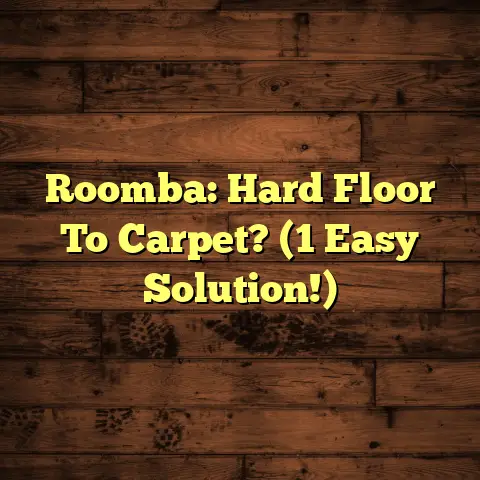Click Flooring: How It Works? (3 Install Secrets!)
In a world where traditional craftsmanship is revered, the rise of click flooring represents both innovation and simplicity.
It brings the art of flooring installation to the masses while seemingly undermining the skilled labor that has long defined the trade.
Let’s dive into everything you need to know to get that flawless floor you’ve been dreaming of!
1. Introduction to Click Flooring
Click flooring has exploded in popularity, and for good reason.
It’s basically flooring designed for easy installation – the pieces click together, no glue or nails needed!
Compared to traditional methods like hardwood nailing or tile setting with mortar, it’s a total game-changer.
Think of it as adult LEGOs for your floors!
The appeal is obvious: DIY projects are booming.
People want to save money and feel the satisfaction of improving their homes themselves.
Click flooring makes that possible, even if you’re a complete newbie.
2. The Mechanics of Click Flooring
So, what exactly is click flooring?
Well, it’s a multi-layered product.
Typically, you’ll find these layers:
-
Wear Layer: This is the top layer, the one you walk on. It’s made of durable material like vinyl or laminate to resist scratches and wear.
-
Design Layer: This layer gives the flooring its look – a wood grain, tile pattern, or whatever design you choose.
-
Core Layer: This is the heart of the flooring, providing stability and water resistance. It could be made of SPC (Stone Polymer Composite), WPC (Wood Polymer Composite), or even high-density fiberboard (HDF) in some laminate options.
-
Underlayment (Optional): Some click flooring comes with a pre-attached underlayment for added comfort and sound insulation.
But the real magic is in the locking mechanism.
These are precisely engineered grooves and ridges on the edges of each plank or tile.
When you line them up and press them together, they snap into place, creating a tight, secure seam.
Think of it like a zipper for your floor.
Here’s a simple breakdown of how it works:
-
Positioning: You angle one plank slightly and insert its tongue (the protruding edge) into the groove of the adjacent plank.
-
Locking: You then press down on the plank until you hear or feel a “click,” indicating that the locking mechanism has engaged.
-
Securing: This process creates a mechanical bond, holding the planks together tightly.
This interlocking system is what makes click flooring so easy to install, even for beginners.
(Imagine a diagram here showing a close-up of the tongue-and-groove system, highlighting how the pieces interlock. A cutaway view showing the layers of the flooring would also be helpful.)
3. The Benefits of Click Flooring
Okay, so it’s easy to install, but what else makes click flooring so great?
Let’s break down the advantages:
-
Ease of Installation: This is the big one. As I mentioned, no glue, no nails, no special tools required (beyond a utility knife and maybe a tapping block). You can often install a whole room in a single weekend.
-
Cost-Effectiveness: Not only do you save on labor costs by doing it yourself, but click flooring itself can often be more affordable than traditional options.
-
Aesthetic Variety: You’re spoiled for choice! Click flooring comes in a huge range of styles, colors, and patterns. Whether you want a rustic wood look, a sleek modern tile, or something completely unique, you’ll find it.
-
Durability: Many click flooring options are incredibly durable, scratch-resistant, and waterproof or water-resistant. SPC and WPC cores are particularly good at handling moisture.
-
Eco-Friendly Options: Look for click flooring made from recycled materials or with low VOC (Volatile Organic Compounds) emissions. Many manufacturers are now focusing on sustainability.
According to Statista, the global resilient flooring market (which includes click vinyl and other similar products) is projected to reach over \$100 billion by 2027. That’s a lot of people choosing click flooring!
4. Secret #1: The Importance of Subfloor Preparation
Alright, now for the secrets! And this first one is crucial.
Your subfloor is the foundation of your entire flooring project. If it’s not prepped correctly, your click flooring will suffer, no matter how well you install it.
Here’s what you need to do:
-
Assess the Subfloor: Is it level? Are there any cracks, holes, or uneven spots? Use a level and a straight edge to check for any dips or bumps.
-
Clean Thoroughly: Sweep, vacuum, and even mop the subfloor to remove all dust, debris, and old adhesive residue.
-
Repair Imperfections: Fill any cracks or holes with a concrete patching compound. Level out any uneven spots with a self-leveling underlayment.
-
Ensure Dryness: Moisture is the enemy! Use a moisture meter to check the moisture content of the subfloor. It should be within the manufacturer’s recommended range (usually below 3%).
Common Pitfalls:
-
Ignoring Small Cracks: Even hairline cracks can cause problems down the road. Fill them!
-
Installing Over Uneven Surfaces: This will lead to flexing and potential damage to the click flooring.
-
Skipping the Moisture Test: Trapped moisture can cause mold, mildew, and warping.
Tips for Fixing Existing Flooring Issues:
-
Wood Subfloors: Replace any damaged or rotted wood. Secure any loose boards with screws.
-
Concrete Subfloors: Grind down any high spots. Fill any cracks with a concrete patching compound.
-
Existing Tile or Vinyl: If it’s in good condition and level, you might be able to install click flooring over it. But make sure it’s clean, dry, and securely bonded to the subfloor.
I can’t stress this enough: Don’t skip subfloor prep! It’s the foundation for a long-lasting, beautiful floor.
5. Secret #2: Understanding the Acclimation Process
This is another secret that many DIYers overlook, and it can lead to major headaches down the line.
Acclimation is the process of allowing your click flooring to adjust to the temperature and humidity of the room where it will be installed.
Why is it so important? Because wood and vinyl (the materials used in click flooring) expand and contract with changes in temperature and humidity.
If you install flooring that hasn’t acclimated, it could buckle, warp, or develop gaps after installation.
Recommended Duration and Conditions:
-
Unpack the Flooring: Remove the flooring from its packaging and spread it out in the room where it will be installed.
-
Temperature: The room temperature should be between 65°F and 75°F (18°C and 24°C).
-
Humidity: The relative humidity should be between 30% and 50%.
-
Duration: The recommended acclimation time is usually 48 to 72 hours, but always check the manufacturer’s instructions.
How Failure to Acclimate Can Lead to Problems:
-
Expansion: The flooring expands after installation, causing it to buckle or push against the walls.
-
Contraction: The flooring shrinks after installation, creating gaps between the planks.
-
Warping: Uneven expansion or contraction can cause the flooring to warp and become uneven.
Pro Tip: Use a hygrometer to monitor the temperature and humidity in the room during acclimation.
I’ve seen countless flooring projects ruined because people skipped this simple step. Don’t let it happen to you!
6. Secret #3: Mastering the Installation Technique
Okay, you’ve prepped your subfloor and acclimated your flooring. Now it’s time for the fun part: installation!
Here’s a step-by-step guide, with tips for avoiding common mistakes:
-
Plan Your Layout: Start by measuring the room and determining the best direction to lay the flooring. Consider the placement of doorways, windows, and other features.
-
Start in a Corner: Begin installing the flooring in a corner of the room, with the tongue side facing the wall.
-
Click the Planks Together: Angle the first plank and insert its tongue into the groove of the adjacent plank. Press down until you hear or feel a “click.”
-
Use a Tapping Block: If the planks are difficult to click together, use a tapping block and a hammer to gently tap them into place.
-
Maintain Expansion Gaps: Leave a small expansion gap (usually about 1/4 inch) around the perimeter of the room. This allows the flooring to expand and contract without buckling.
-
Cut Planks as Needed: Use a utility knife or a flooring cutter to cut planks to fit around obstacles or at the end of a row.
-
Stagger the Seams: Stagger the seams between rows to create a more visually appealing and structurally sound floor.
-
Install Transitions: Use transition strips to cover the expansion gaps at doorways and where the flooring meets other types of flooring.
Common Mistakes to Avoid:
-
Misalignment: Make sure the planks are properly aligned before clicking them together.
-
Inadequate Spacing: Don’t force the planks together too tightly. Leave the recommended expansion gaps.
-
Using Too Much Force: If the planks are difficult to click together, don’t force them. Check for obstructions or misalignment.
Tips for a Seamless Finish:
-
Use a Level: Regularly check the level of the flooring as you install it.
-
Clean Up as You Go: Wipe up any spills or debris immediately.
-
Use the Right Tools: Invest in a good quality utility knife, tapping block, and flooring cutter.
How to Handle Corners and Edges:
-
Inside Corners: Use a coping saw to cut the flooring to fit snugly into inside corners.
-
Outside Corners: Use a miter saw to cut the flooring at a 45-degree angle for outside corners.
-
Edges: Use edge trim or baseboards to cover the expansion gaps along the walls.
I’ve seen people rush through the installation process and end up with a floor that looks… well, not so great. Take your time, be patient, and pay attention to detail.
7. Maintenance and Care for Click Flooring
You’ve got your beautiful new click floor installed. Now, how do you keep it looking its best?
Here’s some guidance on maintenance and care:
-
Regular Cleaning: Sweep or vacuum the floor regularly to remove dirt and debris.
-
Damp Mopping: Mop the floor with a damp mop and a mild detergent. Avoid using excessive water, as this can damage the flooring.
-
Use the Right Products: Use cleaning products that are specifically designed for click flooring. Avoid using abrasive cleaners, bleach, or ammonia.
-
Protect from Scratches: Use furniture pads under the legs of furniture to protect the floor from scratches.
-
Avoid Heavy Impacts: Avoid dropping heavy objects on the floor, as this can dent or damage it.
Addressing Common Concerns:
-
Scratching: Minor scratches can often be buffed out with a scratch repair kit.
-
Denting: Dents can be difficult to repair, but you may be able to conceal them with a rug or furniture.
-
Moisture Damage: Clean up any spills immediately to prevent moisture damage. If the flooring gets wet, dry it as quickly as possible.
What to Avoid:
-
Steam Mops: Steam mops can damage click flooring by forcing moisture into the seams.
-
Abrasive Cleaners: Abrasive cleaners can scratch and dull the surface of the flooring.
-
Excessive Water: Excessive water can seep into the seams and damage the core of the flooring.
With proper care and maintenance, your click flooring will look beautiful for years to come!
8. Real-Life Case Studies
Let’s hear from some folks who’ve taken the plunge and installed click flooring themselves.
Case Study 1: Sarah’s Kitchen Makeover
Sarah, a busy mom of two, wanted to update her kitchen without breaking the bank. She chose a click vinyl flooring that looked like real wood.
“I was intimidated at first,” she said, “but the installation was surprisingly easy. The hardest part was prepping the subfloor, but once that was done, the flooring just clicked together. I saved a ton of money by doing it myself, and I’m so proud of the results!”
Case Study 2: John’s Basement Transformation
John, a retired teacher, decided to finish his basement and wanted a durable, waterproof flooring option. He chose a click SPC flooring.
“The water resistance was a big selling point for me,” he said. “I had a little leak in the past, and I didn’t want to worry about water damage. The installation was straightforward, and the floor looks fantastic. It’s transformed my basement into a comfortable and usable space.”
Case Study 3: Maria’s Rental Property Upgrade
Maria, a property manager, needed to quickly and affordably update the flooring in a rental unit. She chose a click laminate flooring.
“Time is money in my business,” she said. “Click flooring allowed me to update the flooring quickly and efficiently, minimizing downtime. The tenants love the new look, and I’m happy with the durability and ease of maintenance.”
These are just a few examples of how click flooring can transform a space. With a little planning and effort, you can achieve amazing results!
9. Conclusion
So, there you have it – a deep dive into the world of click flooring!
We’ve covered everything from the mechanics of the locking system to the importance of subfloor preparation and acclimation.
We’ve also shared some secrets for mastering the installation technique and maintaining your new floor.
Click flooring offers a winning combination of affordability, ease of installation, and aesthetic appeal. It’s a game-changer for DIY enthusiasts and homeowners alike.
As technology continues to evolve, the future of flooring is sure to be filled with even more innovative and user-friendly options.
Click flooring is just the beginning!
Now, go forth and create the floor of your dreams! And remember, I’m always here to answer any questions you might have. Happy flooring!





